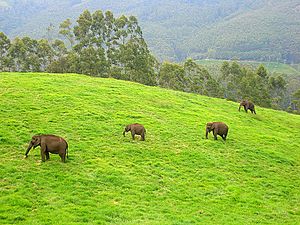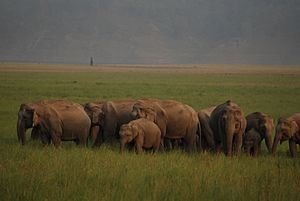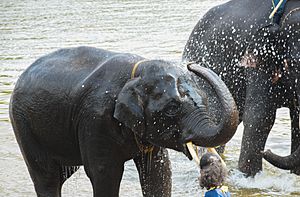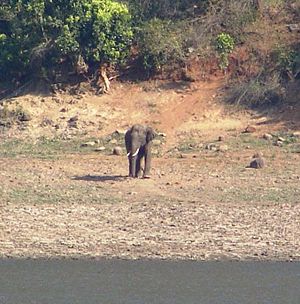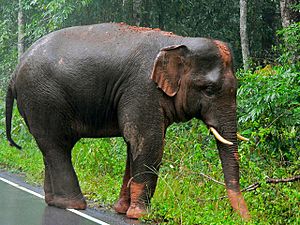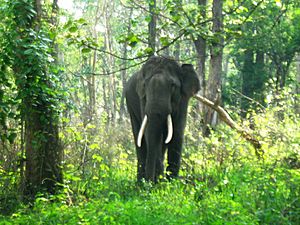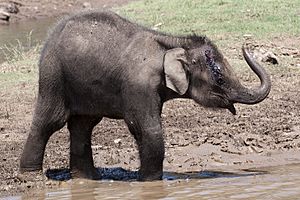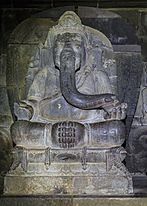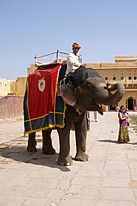Indian elephant facts for kids
Quick facts for kids Indian elephantTemporal range: Pleistocene – Recent
|
|
|---|---|
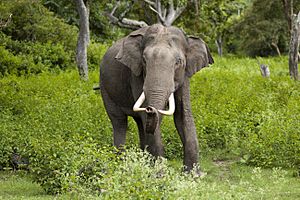 |
|
| Tusked male in Bandipur National Park | |
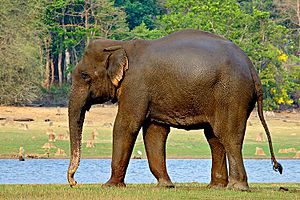 |
|
| Female in Nagarhole National Park | |
| Conservation status | |
| Scientific classification |
|
| Kingdom: | Animalia |
| Phylum: | Chordata |
| Class: | Mammalia |
| Order: | Proboscidea |
| Family: | Elephantidae |
| Genus: | Elephas |
| Species: | |
| Subspecies: |
E. m. indicus
|
| Trinomial name | |
| Elephas maximus indicus Cuvier, 1798
|
|
| Synonyms | |
|
E. m. bengalensis de Blainville, 1843 |
|
The Indian elephant (Elephas maximus indicus) is a type of Asian elephant. It is one of three main kinds of Asian elephants that are still alive today. These amazing animals live in mainland Asia.
Since 1986, the Asian elephant has been listed as an Endangered animal. This means their numbers in the wild have dropped a lot. Their population has gone down by at least half since the 1930s and 1940s. Elephants face threats like losing their homes, their habitats getting damaged, and their living areas being broken up.
Contents
What Indian Elephants Look Like
Asian elephants are generally smaller than African elephants. The highest point on their body is on their head. The tip of their trunk has one finger-like part. Their back can be curved or flat.
Indian elephants can stand between 2 and 3 meters (about 6.5 to 10 feet) tall at the shoulder. They weigh between 2,000 and 5,000 kilograms (about 4,400 to 11,000 pounds). They have 19 pairs of ribs. Their skin is lighter than some other Asian elephants. It is also darker than the Sumatran elephant. Female elephants are usually smaller than males. They often have short tusks or no tusks at all.
The tallest Indian elephant ever recorded was 3.43 meters (about 11.25 feet) high at the shoulder. In 1985, two very large male elephants were seen in Bardia National Park. They were named Raja Gaj and Kanchha. Raja Gaj was known for his huge size and very prominent forehead. People compared his look to ancient animals like the Stegodon and mammoth.
Indian elephants have smaller ears than African elephants. However, they have wider skulls and larger trunks. Their toes are big and wide. Unlike African elephants, their belly size matches their body weight. African elephants, though, have a large belly compared to their heads.
Where Indian Elephants Live
The Indian elephant lives in many parts of mainland Asia. These include India, Nepal, Bangladesh, Bhutan, Myanmar, Thailand, Malay Peninsula, Laos, China, Cambodia, and Vietnam. Sadly, they are no longer found in Pakistan.
They live in different types of forests and open areas. These include grasslands, dry and moist deciduous forests, and evergreen and semi-evergreen forests.
In the early 1990s, here's where wild Indian elephants were found:
- India: Between 27,785 and 31,368 elephants. They live in four main areas:
- Nepal: 100–125 elephants, mostly in protected areas along the border with India.
- Bangladesh: 150–250 elephants, in isolated groups in the Chittagong Hills.
- Bhutan: 250–500 elephants, in southern protected areas.
- Myanmar: 4,000–5,000 elephants, but their groups are very spread out.
- Thailand: 2,500–3,200 elephants, mainly in the mountains near Myanmar.
- Malaysia: 2,100–3,100 elephants.
- Laos: 500–1,000 elephants, found in many forested areas.
- China: 200–250 elephants, only in southern Yunnan province.
- Cambodia: 250–600 elephants, mostly in the southwestern mountains.
- Vietnam: 70–150 elephants, in the southern parts of the country.
Elephant Corridors
Elephants need special paths to move safely between different areas. These paths are called elephant corridors. There are 138 corridors within states, 28 between states, and 17 that cross international borders. These corridors help Indian elephants move around.
| Region | Number of Corridors | Area (km2) | Percentage of elephant population |
|---|---|---|---|
| North-East | 58 | 41,000 | 33% |
| East | 54 | 23,500 | 10% |
| North | 8 | 5,500 | 4% |
| South | 46 | 40,000 | 53% |
What Indian Elephants Eat and Do
Elephants are very large plant-eaters, called megaherbivores. They can eat up to 150 kilograms (about 330 pounds) of plants every day! They eat many different kinds of plants, both by grazing on grasses and browsing on leaves and twigs.
In one study in southern India, elephants were seen eating 112 different types of plants. They often ate plants from the mallow family, peas, palms, sedges, and true grasses. They eat tall grasses, but what part they eat changes with the season. When new grass grows in April, they eat the soft tops. Later, when grasses are taller, they pull up whole clumps. They skillfully dust them off and eat the fresh leaves, throwing away the roots. When grasses are old in autumn, they eat the juicy bottom parts with the roots.
From bamboo plants, they eat young shoots and stems. During the dry season, from January to April, they mostly eat leaves and twigs. They prefer fresh leaves. They can even eat thorny shoots from acacia trees without trouble. They also eat the bark of certain trees and fruits like wood apple and tamarind.
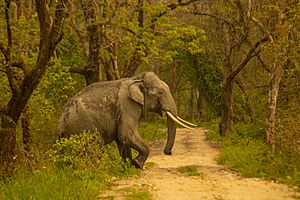
In Nepal's Bardia National Park, elephants eat a lot of floodplain grass, especially during the monsoon season. In the dry season, they browse more, and tree bark becomes a big part of their diet. Another study in Assam found elephants eating about 20 types of grasses, plants, and trees. Grasses were the most important part of their diet.
Scientists studied how elephants move and use their habitat in southern India from 1981 to 1983. This area had different types of forests, from dry thorn forests to evergreen forests. Five different elephant families, each with 50 to 200 elephants, had their own home areas. These areas ranged from 105 to 320 square kilometers (about 40 to 124 square miles) and often overlapped.
Elephants prefer places where they can find water and tasty food plants. During the dry months, they gather in river valleys. Here, the plants have more protein than the tough grasses on hills. When the rains start in May, they spread out into the tall grass forests. They eat the fresh grasses, which are now full of protein. During the second wet season, from September to December, the tall grasses become tough. So, the elephants move to lower areas with shorter, open forests. Even though conditions can change, elephants in this region have followed similar movement patterns for over a hundred years.
In the Nilgiri Biosphere Reserve, three elephant families had large home ranges in the early 1990s. These areas were between 562 and 799 square kilometers (about 217 to 308 square miles). Over three years, their home ranges mostly stayed the same, with only small changes each year.
Protecting Indian Elephants
The biggest dangers to Asian elephants today are losing their homes, their habitats getting damaged, and their living areas being broken up. This happens because the human population is growing. This also leads to more conflicts between humans and elephants. For example, elephants might eat or damage crops.
Many things stop elephants from moving freely. These include water reservoirs, hydroelectric projects, irrigation dams, farms, roads, railway lines, mining, and new buildings.
Sadly, poaching (illegal hunting) elephants for their ivory is a serious problem in some parts of Asia.
Project Elephant
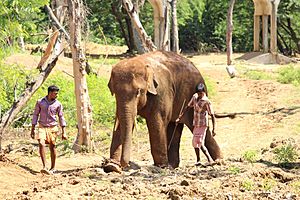
Project Elephant started in 1992 in India. The Indian government created it to help protect wild Asian elephants. The project gives money and support to states to manage their elephant populations.
The main goal of Project Elephant is to make sure elephants can survive for a long time in their natural homes. They do this by protecting the elephants, their habitats, and their migration paths. Other goals include:
- Supporting research on elephant behavior and how to manage them.
- Teaching local people about elephant conservation.
- Providing better care for elephants living in captivity.
Indian Elephants in Culture
The Indian elephant is a very important cultural symbol across Asia. It appears in many religious traditions and old stories. Elephants are often seen as good symbols. They are sometimes even worshipped as gods. They often represent strength and wisdom.
In Thailand, the elephant is the national animal. In India, it has been named the national heritage animal. (The tiger is the national animal of India.) The Indian elephant is also the state animal for the Indian states of Jharkhand, Karnataka, Kerala, and Odisha. It is also the national animal of Laos.
See also
 In Spanish: Elefante indio para niños
In Spanish: Elefante indio para niños




